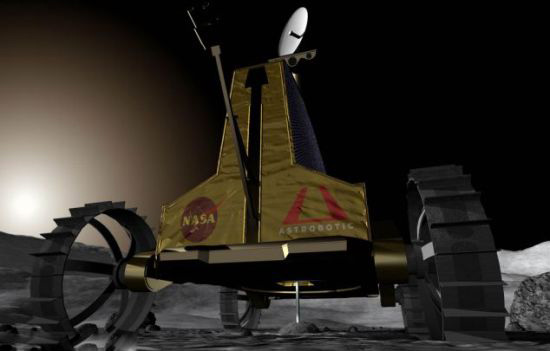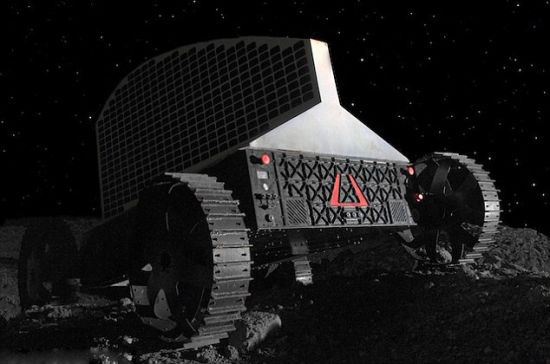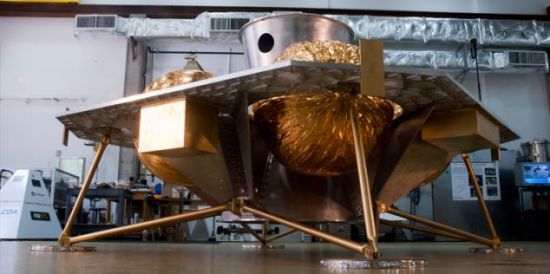 |
Original working prototype of the "North Star" rover. This lunar rover is expected to land on the moon in 2015.

The task of searching for water ice "Polaris" can drill down to a depth of 1 meter to find signs of water ice

Will find water ice on the moon. Water Ice can help future explorers build moon bases

The lander used to land the Polaris on the moon is still under development
"Curious" has started to investigate on the surface of Mars, and the moon will also soon receive a lunar rover named "Polaris" to carry out the water ice exploration mission. On the 10th, Astrobotic Technology unveiled the mystery of the "Polaris." This lunar rover is expected to take SpaceX’s rockets to the moon in October 2015.
"Polaris" adopts solar panels, and people can not help but think of Moxi Dryhead. After the moon landing, the rover will look for traces of water ice on the moon. Water ice can help future lunar explorers build moon bases. The "Polaris" is the first solar-powered robot used to search the moon for potentially abundant water ice. According to observations from NASA and Indian spacecraft, there is a large amount of water ice in the polar regions of the moon. Researchers say water ice is the source of water, fuel, and oxygen for future moon explorers.
The "Polaris" can drill down to a depth of 1 meter and can also perform exploration missions in the dark moon. The destination of this lunar rover is the North Pole of the Moon and will eventually be launched from Space Cape’s Falcon 9 launch vehicle from Cape Canaveral. The "North Star" unveiled this time is a prototype vehicle and has the same structure as the final moon landing version. It uses a large number of components suitable for flying, including wheels and chassis beams made of light and strong synthetic materials.
In the coming months, the team of Aerospace Robotics will test Polaris' computer vision, navigation, and planning software and positioning software with an accuracy of up to 10 feet (about 3 meters). The CEO of Aerospace Robotics is William Whitaker of Carnegie Mellon University, responsible for developing robotics for planetary exploration missions. Whitaker said: "It is the first robot designed specifically for drilling moon ice."
Polaris was developed by the Field Robotics Technology Center. The center has been developing robotics for lunar exploration, but no robot has ever been sent to the moon. Whitaker pointed out: "The Polaris robot incorporates many ideas and has the ability to find water ice on the moon." In order to find water ice, the lunar rover must explore as close to the dark polar region as possible, but not too close , so as not to use solar panels to generate electricity.
The Polaris is equipped with three large solar panels arranged vertically to capture sunlight near the horizon. The three panels generate an average of 250 watts. In addition, "Polaris" also uses software developed by Carnegie Mellon University for the NASA-funded "Hyperion" robot project to track the position of "Polaris" relative to light in order to maximize power generation. , making it possible to perform exploration missions in polar dark areas.
Whitaker said that one-month ball day is equivalent to about 14 Earth days, and that it can only find water ice in the polar regions for about 10 days. The team of Aerospace Robotics hopes that Polaris will be able to drill 10 to 100 holes during this time to search for water ice. The company worked with Carnegie Mellon University to compete for a $20 million Google Moon X award. In order to get this bonus, Aerospace Robotics has developed two kinds of lunar rover. One of them is Polaris.
Google has set aside $30 million for a privately funded lunar exploration project. The first prize of 20 million U.S. dollars will be awarded to companies that have successfully allowed robots to land on the moon and travel 500 meters to return videos, pictures and data to the Earth. If the "Polaris" can withstand the long and cold moon night test, the water ice exploration mission will have very bright prospects. Currently, aerospace robotics company has obtained nine contracts related to the moon exploration mission from NASA, totaling 3.6 million U.S. dollars. This includes evaluating the use of spacecraft by Polaris when it travels 3 miles (about 4,800 meters) near the North Pole. Bureau of water ice exploration equipment to perform missions. (xiaowen)
Integral Hydraulic Puller,Integral Hydraulic Bearing Puller,Integral Hydraulic Pin Puller,Integral Hydraulic Gear Puller
Jiangsu JOBA Mechanical Manufacture Co., Ltd , https://www.jsjoba.com